Analysis of Factors Influencing the Corporate Performance of Listed Companies in China’s Agriculture and Forestry Sector Based on a Panel Threshold Model
Abstract
:1. Introduction
2. Literature Review
3. Variable Selection and Hypothesis Formulation
3.1. Data Sources
3.2. Variable Selection
3.2.1. Explanatory Variables
3.2.2. Explanatory Variables
3.2.3. Control Variables
3.3. Hypothesis Formulation
3.4. Entropy Weighting Method
4. Empirical Analysis
4.1. GMM Model
4.1.1. Model Construction
4.1.2. Results of GMM Estimation
4.2. Panel Threshold Models
4.2.1. Model Construction
4.2.2. Model Results
5. Conclusions and Recommendations
5.1. Conclusions
5.2. Recommendations
6. Research Shortcomings and Perspectives
Author Contributions
Funding
Institutional Review Board Statement
Informed Consent Statement
Data Availability Statement
Acknowledgments
Conflicts of Interest
Appendix A
References
- Liu, H.; Fan, L.; Shao, Z. Threshold effects of energy consumption, technological innovation, and supply chain management on enterprise performance in China’s manufacturing industry. J. Environ. Manag. 2021, 300, 113687. [Google Scholar] [CrossRef]
- Fan, L.; Liu, H.; Shao, Z.; Li, C. Panel Data Analysis of Energy Conservation and Emission Reduction On High-Quality Development of Logistics Industry in Yangtze River Delta of China. Environ. Sci. Pollut. Res. Int. 2021, 29, 78361–78380. [Google Scholar] [CrossRef] [PubMed]
- Liu, J.; Li, Q. Impact of Major Events on Interprovincial Carbon Emissions—Based on PSM-DID Analysis. Sustainability 2021, 14, 7459. [Google Scholar] [CrossRef]
- Liu, H.; Liu, J.; Li, Q. Asymmetric Effects of Economic Development, Agroforestry Development, Energy Consumption, and Population Size on CO2 Emissions in China. Sustainability. 2022, 14, 7144. [Google Scholar] [CrossRef]
- Mishra, A.; Bruno, E.; Zilberman, D. Compound natural and human disasters: Managing drought and COVID-19 to sustain global agriculture and food sectors. Sci. Total Environ. 2021, 754, 142210. [Google Scholar] [CrossRef] [PubMed]
- Zhu, W.; Wang, R. Impact of farm size on intensity of pesticide use: Evidence from China. Sci. Total Environ. 2021, 753, 141696. [Google Scholar] [CrossRef] [PubMed]
- Wang, K.L.; Zhao, B.; Ding, L.L.; Miao, Z. Government intervention, market development, and pollution emission efficiency: Evidence from China. Sci. Total Environ. 2021, 757, 143738. [Google Scholar] [CrossRef] [PubMed]
- Raimondo, M.; Caracciolo, F.; Balo, L.; Chinnici, G.; Pecorino, B.; D’Amico, M. Making virtue out of necessity: Managing the citrus waste supply chain for bioeconomy applications. Sustainability 2018, 10, 4821. [Google Scholar] [CrossRef] [Green Version]
- FAO. FAO’s Investment Centre Is Stepping Up Its Support for Creating More Robust and Sustainable Agrifood Systems. 2020. Available online: https://www.fao.org/news/story/en/item/1366309/icode (accessed on 21 September 2020).
- Kumar, R.; Mukherjee, S.; Choi, T.; Dhamotharan, L. Mining voices from self-expressed messages on social-media: Diagnostics of mental distress during COVID-19. Decis. Support Syst. 2022, 162, 113792. [Google Scholar] [CrossRef]
- Li, K.; Zhou, C.; Luo, X.R.; Benitez, J.; Liao, Q. Impact of information timeliness and richness on public engagement on social media during COVID-19 pandemic: An empirical investigation based on NLP and machine learning. Decis. Support Syst. 2022, 162, 113752. [Google Scholar] [CrossRef]
- FAO. The Future of Food and Agriculture—Trends and Challenges; FAO: Rome, Italy, 2017; Available online: https://www.fao.org/news/archive/news-by-date/2017/en (accessed on 28 October 2022).
- Bekele, R.D.; Mirzabaev, A.; Mekonnen, D. Adoption of multiple sustainable land management practices among irrigator rural farm households of Ethiopia. Land Degrad. Dev. 2021, 32, 5052–5068. [Google Scholar] [CrossRef]
- NOAA. National Oceanic and Atmospheric SafetyAdministration. 2022. Available online: https://www.noaa.gov/research (accessed on 21 June 2022).
- Adelodun, B.; Kim, S.H.; Odey, G.; Choi, K.S. Assessment of environmental and economic aspects of household food waste using a new Environmental-Economic Footprint (EN-EC) index: A case study of Daegu, South Korea. Sci. Total Environ. 2021, 776, 145928. [Google Scholar] [CrossRef] [PubMed]
- Lu, S.; Wang, F.; Meng, P.; Zhang, J. Simultaneously protecting the environment and its residents: The need to incorporate agroforestry principles into the ecological projects of China. Ecol. Indic. 2015, 57, 61–63. [Google Scholar] [CrossRef]
- He, J.; Zhou, Z.; Weyerhaeuser, H.; Xu, J. Participatory technology development for incorporating non-timber forest products into forest restoration in Yunnan, Southwest China. For. Ecol. Manag. 2009, 257, 2010–2016. [Google Scholar] [CrossRef]
- Tomasz, S.; Tomasz, N.; Tamara, J.; Magdalena, S. Influence of Reduced Tillage, Fertilizer Placement, and Soil Afforestation on CO2 Emission from Arable Sandy Soils. Agronomy 2022, 12, 3102. [Google Scholar] [CrossRef]
- Zhang, C.; Zhao, Z.; Li, F.; Zhang, J. Effects of Organic and Inorganic Fertilization on Soil Organic Carbon and Enzymatic Activities. Agronomy 2022, 12, 3125. [Google Scholar] [CrossRef]
- Guo, L.; Ma, L.; Wang, G.; Chen, X.; Li, Z.; Wang, M.; Che, Y.; Zhang, L.; Jie, S.; Jiang, Z. Changes in Rhizosphere Soil Nutrients, Enzyme Activities, and Microbial Communities at Different Stages of Industrial Hemp Development. Agronomy 2022, 12, 3159. [Google Scholar] [CrossRef]
- Flores-Velazquez, J.; Mendoza-Perez, C.; Rubiños-Panta, J.E.; Ruelas-Islas, J.D. Quality and Yield of Bell Pepper Cultivated with Two and Three Stems in a Modern Agriculture System. Horticulturae 2022, 8, 1187. [Google Scholar] [CrossRef]
- Sun, Y.; Cao, F.; Wei, X.; Welham, C.; Chen, L.; Pelz, D.R.; Yang, Q.; Liu, H. An Ecologically Based System for Sustainable Agroforestry in Sub-Tropical and Tropical Forests. Forests 2017, 8, 102. [Google Scholar] [CrossRef]
- Li, S.; Zhu, C.; Lin, Y.; Dong, B.; Chen, B.; Si, B.; Li, Y.; Deng, X.; Gan, M.; Zhang, J.; et al. Conflicts between agricultural and ecological functions and their driving mechanisms in agroforestry ecotone areas from the perspective of land use functions. J. Clean. Prod. 2021, 317, 128453. [Google Scholar] [CrossRef]
- Lin, W.; Huang, X.; Fang, H.; Wang, V.; Hua, Y.; Wang, J.; Yin, H.; Yi, D.; Yau, L. Blockchain technology in current agricultural systems: From techniques to applications. IEEE Access 2020, 8, 143920. [Google Scholar] [CrossRef]
- Nayak, S. Remote sensing for national development: The Legacy of Dr. Vikram Sarabhai. J. Indian Soc. Remote. Sens. 2020, 48, 1101–1120. [Google Scholar] [CrossRef]
- Asfaw, S.; Branca, G. Introduction and overview. In Climate Smart Agriculture-Building Resilience to Climate Change; Lipper, L., McCarthy, N., Zilberman, D., Asfaw, S., Branca, G., Eds.; Springer: New York, NY, USA, 2018; p. 3e12. [Google Scholar] [CrossRef] [Green Version]
- Zhang, F.; Wang, F.; Hao, R.; Wu, L. Agricultural Science and Technology Innovation, Spatial Spillover and Agricultural Green Development—Taking 30 Provinces in China as the Research Object. Appl. Sci. 2022, 12, 845. [Google Scholar] [CrossRef]
- Luo, Y.; Salman, M.; Lu, Z. Heterogeneous impacts of environmental regulations and foreign direct investment on green innovation across different regions in China. Sci. Total Environ. 2021, 759, 143744. [Google Scholar] [CrossRef]
- Mardiharini, M.; Hanifah, V.W.; Dewi, Y.A. Advisory innovation model on Indonesian farmers corporation’s development. IOP Conf. Ser. Earth Environ. Sci. 2021, 644, 012051. [Google Scholar] [CrossRef]
- Pérez, P.D.; Alarcón, V.F.; Drummond, C.; Ortiz, Á. Towards a sustainable agrifood supply chain model. the case of LEAF. In Engineering Digital Transformation; Springer: Berlin/Heidelberg, Germany, 2019; pp. 333–341. [Google Scholar] [CrossRef]
- Fu, H.; Li, J.; Li, Y.; Huang, S.; Sun, X. Risk transfer mechanism for agricultural products supply chain based on weather index insurance. Complexity 2018, 2018, 2369423. [Google Scholar] [CrossRef] [Green Version]
- Chofreh, A.G.; Goni, F.A.; Zeinalnezhad, M.; Navidar, S.; Shayestehzadeh, H.; Klemeš, J.J. Value chain mapping of the water and sewage treatment to contribute to sustainability. J. Environ. Manag. 2019, 239, 38–47. [Google Scholar] [CrossRef]
- Azevedo, S.G.; Silva, M.E.; Matias, J.C.; Dias, G.P. The Influence of collaboration initiatives on the sustainability of the cashew supply chain. Sustainability 2018, 10, 2075. [Google Scholar] [CrossRef]
- Scholz, J.; De Meyer, A.; Marques, A.S.; Pinho, T.M.; Boaventura-Cunha, J.; Van Orshoven, J.; Nummila, K. Digital technologies for forest supply chain optimization: Existing solutions and future trends. J. Environ. Manag. 2018, 62, 1108–1133. [Google Scholar] [CrossRef]
- Leguizamon, F.; Selva, G.; Santos, M. Small farmer suppliers from local to global. J. Bus. Res. 2016, 69, 4520–4525. [Google Scholar] [CrossRef]
- Liu, H.; Sun, M.; Gao, Q.; Liu, J.; Sun, Y.; Li, Q. What Affects the Corporate Performance of Listed Companies in China’s Agriculture and Forestry Industry? Agronomy 2022, 12, 3041. [Google Scholar] [CrossRef]
- Wang, K.; Lu, Q.; Cao, X.; Wang, Y.; Wu, Y.; Chen, Z.; Yang, Z. Application and Development of Natural Plant Metabolite Oleanolic Acid in the Nano Era. Agriculture 2022, 12, 2142. [Google Scholar] [CrossRef]
- Bekraoui, A.; Chakir, S.; Fatnassi, H.; Mouqallid, M.; Majdoubi, H. Climate Behaviour and Plant Heat Activity of a Citrus Tunnel Greenhouse: A Computational Fluid Dynamic Study. AgriEngineering 2022, 4, 1095–1115. [Google Scholar] [CrossRef]
- Xiang, T.; Malik, T.H.; Hou, J.W.; Ma, J. The Impact of Climate Change on Agricultural Total Factor Productivity: A Cross-Country Panel Data Analysis, 1961–2013. Agriculture 2022, 12, 2123. [Google Scholar] [CrossRef]
- Xu, X.; Chen, X.; Zhu, Y.; Zhu, Y. The Effect of R&D Input on Operating Income of Chinese Wastewater Treatment Companies—With Patent Performance as a Mediating Variable. Water 2022, 14, 836. [Google Scholar] [CrossRef]
- Yu, Y.; Xu, Q. Influencing Factors of Enterprise R&D Investment: Post-Subsidy, Sustainability, and Heterogeneity. Sustainability 2022, 14, 5759. [Google Scholar] [CrossRef]
- Boeing, P.; Eberle, J.; Howell, A. The impact of China’s R&D subsidies on R&D investment, technological upgrading and economic growth. Technol. Forecast. Soc. 2022, 174, 121212. [Google Scholar] [CrossRef]
- Xu, J.; Wang, X.; Liu, F. Government subsidies, R&D investment and innovation performance: Analysis from pharmaceutical sector in China. Technol. Anal. Strateg. 2021, 33, 535–553. [Google Scholar] [CrossRef]
- Wang, J.; Yang, N.; Zhang, Y.; Song, Y. Dynamics of firm’s network community associations and firm’s innovation performance. Technol. Anal. Strateg. 2020, 32, 239–255. [Google Scholar] [CrossRef]
- Chebbi, K.; Ammer, M.A. Board Composition and ESG Disclosure in Saudi Arabia: The Moderating Role of Corporate Governance Reforms. Sustainability 2022, 14, 12173. [Google Scholar] [CrossRef]
- Molinder, J.; Karlsson, T.; Enflo, K. Social democracy and the decline of strikes. Explor. Econ. Hist. 2022, 83, 101420. [Google Scholar] [CrossRef]
- Harymawan, I.; Agustia, D.; Nasih, M.; Inayati, A.; Nowland, J. Remuneration committees, executive remuneration, and firm performance in Indonesia. Heliyon 2022, 6, e03452. [Google Scholar] [CrossRef]
- Fareed, Z.; Wang, N.; Shahzad, F.; Shah, S.G.M.; Iqbal, N.; Zulfiqar, B. Does good board governance reduce idiosyncratic risk in emerging markets? Evidence from China. J. Multinatl. Financ. Manag. 2022, 65, 100749. [Google Scholar] [CrossRef]
- Van Essen, M.; Otten, J.; Carberry, E.J. Assessing managerial power theory: A meta-analytic approach to understanding the determinants of CEO compensation. J. Manag. 2015, 41, 164–202. [Google Scholar] [CrossRef] [Green Version]
- Da Silva Stefano, G.; dos Santos Antunes, T.; Lacerda, D.P.; Morandi, M.I.W.M.; Piran, F.S. The impacts of inventory in transfer pricing and net income: Differences between traditional accounting and throughput accounting. Brit. Account. Rev. 2022, 54, 101001. [Google Scholar] [CrossRef]
- Makhazhanova, U.; Kerimkhulle, S.; Mukhanova, A.; Bayegizova, A.; Aitkozha, Z.; Mukhiyadin, A.; Azieva, G. The Evaluation of Creditworthiness of Trade and Enterprises of Service Using the Method Based on Fuzzy Logic. Appl. Sci. 2022, 12, 11515. [Google Scholar] [CrossRef]
- Cho, H.; Lee, P.; Shin, C.H. Executive Turnover and Founder CEO Experience: Effect on New Ventures’ R&D Investment. Economies 2022, 10, 97. [Google Scholar] [CrossRef]
- Surikova, E.; Kosorukova, E.; Krainova, I.; Rasskazova, M. Management of accounts receivable for railway transport enterprises. Transp. Res. Procedia 2022, 63, 1790–1797. [Google Scholar] [CrossRef]
- Liu, L.; Zhan, X. Analysis of financing efficiency of Chinese agricultural listed companies based on machine learning. Complexity 2019, 2019, 9190273. [Google Scholar] [CrossRef] [Green Version]
- Li, M.; Gao, X. Implementation of enterprises’ green technology innovation under market-based environmental regulation: An evolutionary game approach. J. Environ. Manag. 2022, 308, 114570. [Google Scholar] [CrossRef]
- Tordrup, D.; Smith, R.; Kamenov, K.; Bertram, M.Y.; Green, N.; Chadha, S. Global return on investment and cost-effectiveness of WHO’s HEAR interventions for hearing loss: A modelling study. Lancet Glob. Health 2022, 10, e52–e62. [Google Scholar] [CrossRef] [PubMed]
- Shingade, S.; Rastogi, S.; Bhimavarapu, V.M.; Chirputkar, A. Shareholder Activism and Its Impact on Profitability, Return, and Valuation of the Firms in India. J. Risk. Financ. Manag. 2022, 15, 148. [Google Scholar] [CrossRef]
- Ren, X.; Zhang, X.; Yan, C.; Gozgor, G. Climate policy uncertainty and firm-level total factor productivity: Evidence from China. Energ. Econ. 2022, 113, 106209. [Google Scholar] [CrossRef]
- Geng, R.; Bose, I.; Chen, X. Prediction of financial distress: An empirical study of listed Chinese companies using data mining. Eur. J. Oper. Res. 2015, 241, 236–247. [Google Scholar] [CrossRef]
- Altahtamouni, F.; Alfayhani, A.; Qazaq, A.; Alkhalifah, A.; Masfer, H.; Almutawa, R.; Alyousef, S. Sustainable Growth Rate and ROE Analysis: An Applied Study on Saudi Banks Using the PRAT Model. Economies 2022, 10, 70. [Google Scholar] [CrossRef]
- Maung, Y.S.Y.; Douglas, I.; Tan, D. Identifying the drivers of profitable airline growth. Transp. Policy 2022, 115, 275–285. [Google Scholar] [CrossRef]
- Ahsan, T.; Al-GAMRH, B.; Mirza, S.S. Economic policy uncertainty and sustainable financial growth: Does business strategy matter? Financ. Res. Lett. 2022, 46, 102381. [Google Scholar] [CrossRef]
- Lei, Y.; Li, Y. Construction and Simulation of the Market Risk Early-Warning Model Based on Deep Learning Methods. Sci. Program.-Neth. 2022, 2022, 4733220. [Google Scholar] [CrossRef]
- Inaba, K.I. Corporate cash and governance: A global look into publicly-traded companies’ aggregate cash ratios. Int. Rev. Financ. Anal. 2021, 78, 101808. [Google Scholar] [CrossRef]
- Ogachi, D.; Ndege, R.; Gaturu, P.; Zoltan, Z. Corporate bankruptcy prediction model, a special focus on listed companies in Kenya. J. Risk Financ. Manag. 2020, 13, 47. [Google Scholar] [CrossRef] [Green Version]
- Dooner, D.B.; Mundo, D. Unloaded transmission error and instantaneous gear ratio for non-circular gears with misalignments. Mech. Mach. Theory. 2022, 170, 104728. [Google Scholar] [CrossRef]
- Wei, X.; Xu, H.; Zhang, B.; Li, J. Infrastructure operation efficiency and influential factors in developing countries: Evidence from China. Sustainability 2019, 11, 655. [Google Scholar] [CrossRef] [Green Version]
- Liu, F.; Kim, B.C.; Park, K. Supplier-base concentration as a moderating variable in the non-linear relationship between R&D and firm value. Asian J. Technol. Innov. 2020, 30, 342–363. [Google Scholar] [CrossRef]
- Deligianni, I.; Voudouris, I.; Spanos, Y.; Lioukas, S. Non-linear effects of technological competence on product innovation in new technology-based firms: Resource orchestration and the role of the entrepreneur’s political competence and prior start-up experience. Technovation 2019, 88, 102076. [Google Scholar] [CrossRef]
- Paniagua, J.; Rivelles, R.; Sapena, J. Corporate governance and financial performance: The role of ownership and board structure. J. Bus. Res. 2018, 89, 229–234. [Google Scholar] [CrossRef]
- Al-ahdal, W.M.; Alsamhi, M.H.; Tabash, M.I.; Farhan, N.H. The impact of corporate governance on financial performance of Indian and GCC listed firms: An empirical investigation. Res. Int. Bus. Financ. 2020, 51, 101083. [Google Scholar] [CrossRef]
- Nollet, J.; Filis, G.; Mitrokostas, E. Corporate social responsibility and financial performance: A non-linear and disaggregated approach. Econ. Model. 2016, 52, 400–407. [Google Scholar] [CrossRef] [Green Version]
- Matuszak, Ł.; Różańska, E. A non-linear and disaggregated approach to studying the impact of CSR on accounting profitability: Evidence from the Polish banking industry. Sustainability 2019, 11, 183. [Google Scholar] [CrossRef]
- Shabbir, M.S.; Aslam, E.; Irshad, A.; Bilal, K.; Aziz, S.; Abbasi, B.A.; Zia, S. Nexus between corporate social responsibility and financial and non-financial sectors’ performance: A non-linear and disaggregated approach. Environ. Sci. Pollut. Res. 2020, 27, 39164–39179. [Google Scholar] [CrossRef]
- Wamba, S.F.; Dubey, R.; Gunasekaran, A.; Akter, S. The performance effects of big data analytics and supply chain ambidexterity: The moderating effect of environmental dynamism. Int. J. Prod. Econ. 2020, 222, 107498. [Google Scholar] [CrossRef]
- Broadstock, D.C.; Collins, A.; Hunt, L.C.; Vergos, K. Voluntary disclosure, greenhouse gas emissions and business performance: Assessing the first decade of reporting. Br. Account. Rev. 2018, 50, 48–59. [Google Scholar] [CrossRef] [Green Version]
- Fan, M.X.; Xie, C.; Huang, W.L. A study on the timing and manner of venture capital entry into innovative firms based on threshold model. J. Manag. 2019, 7, 1035–1043. [Google Scholar] [CrossRef]
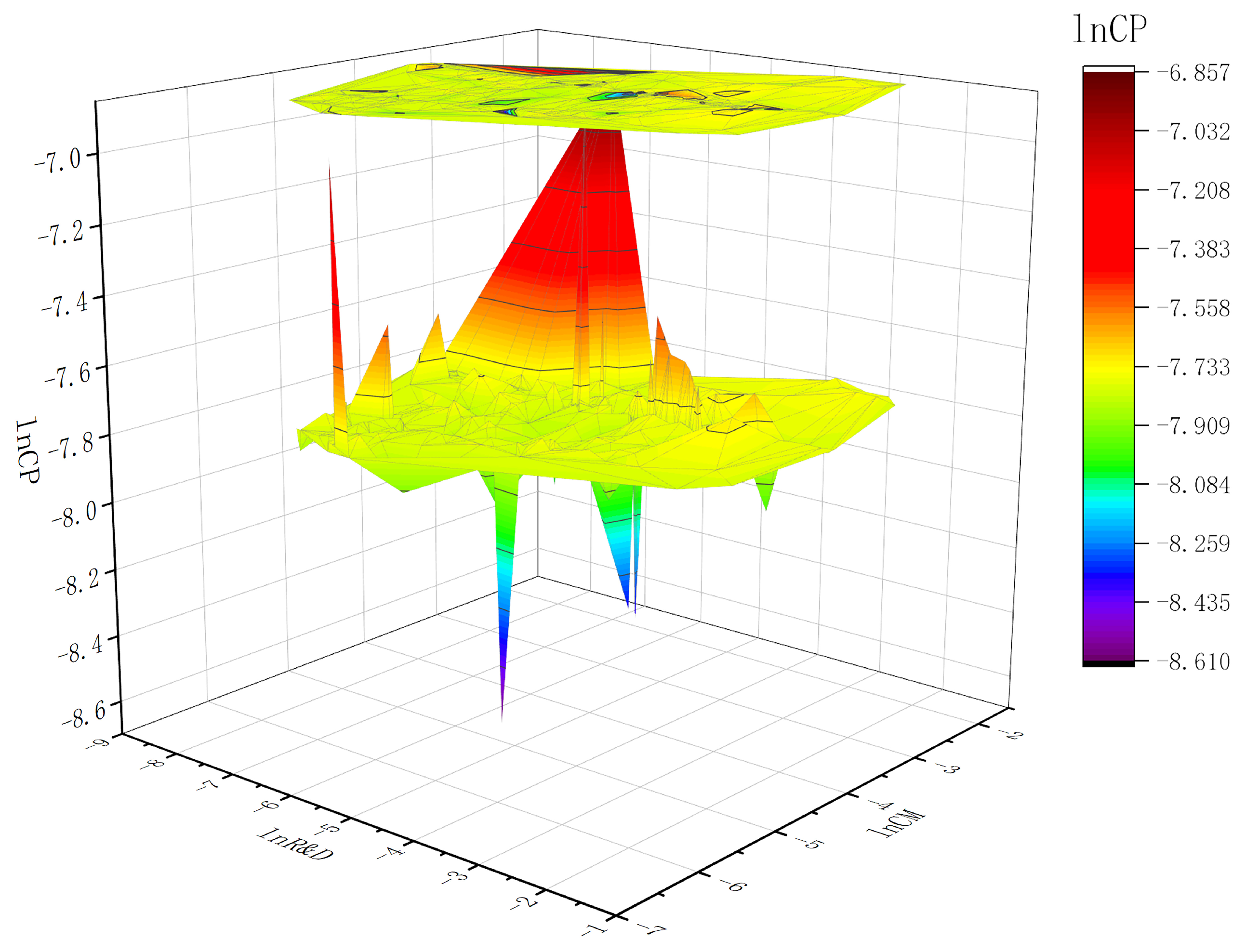

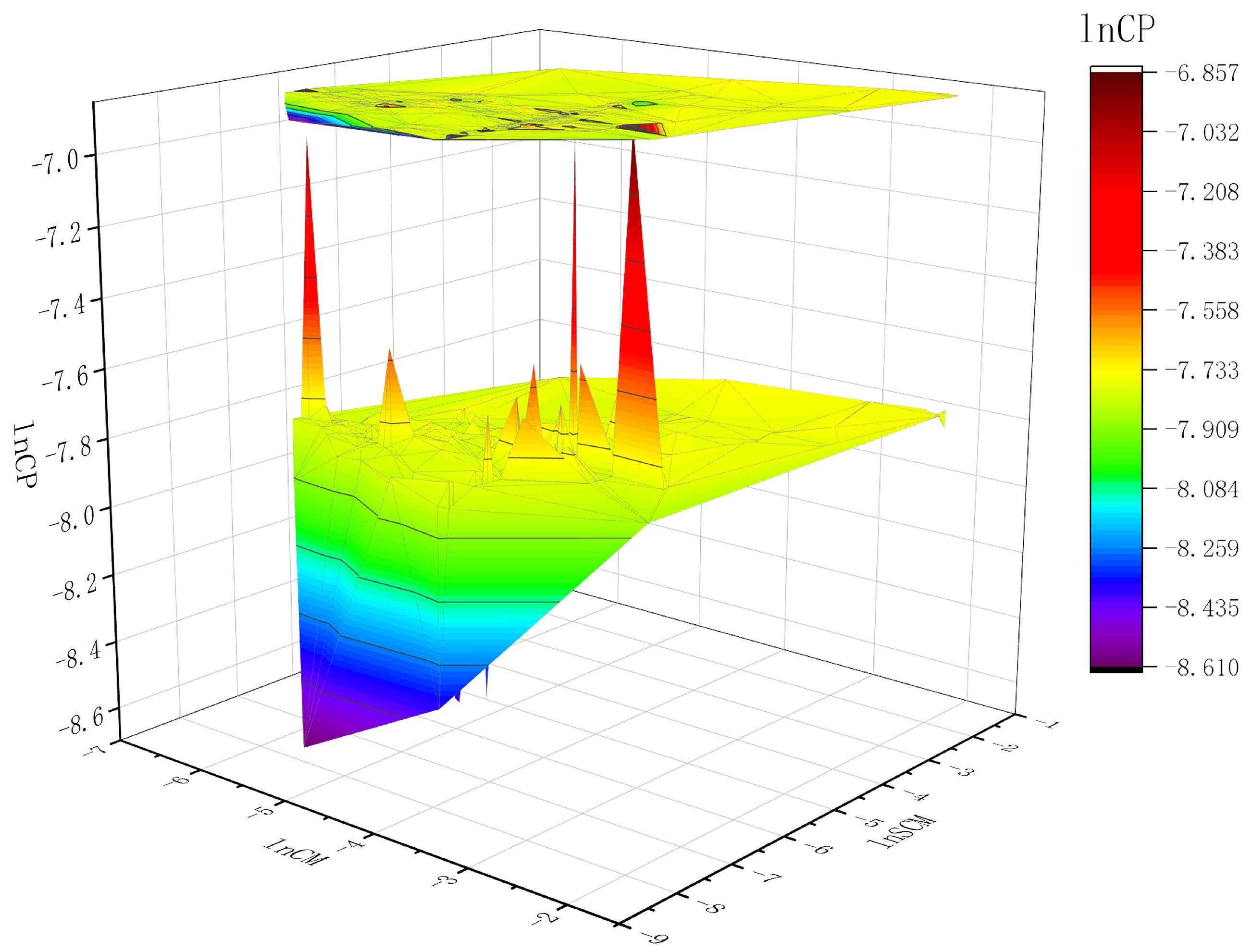
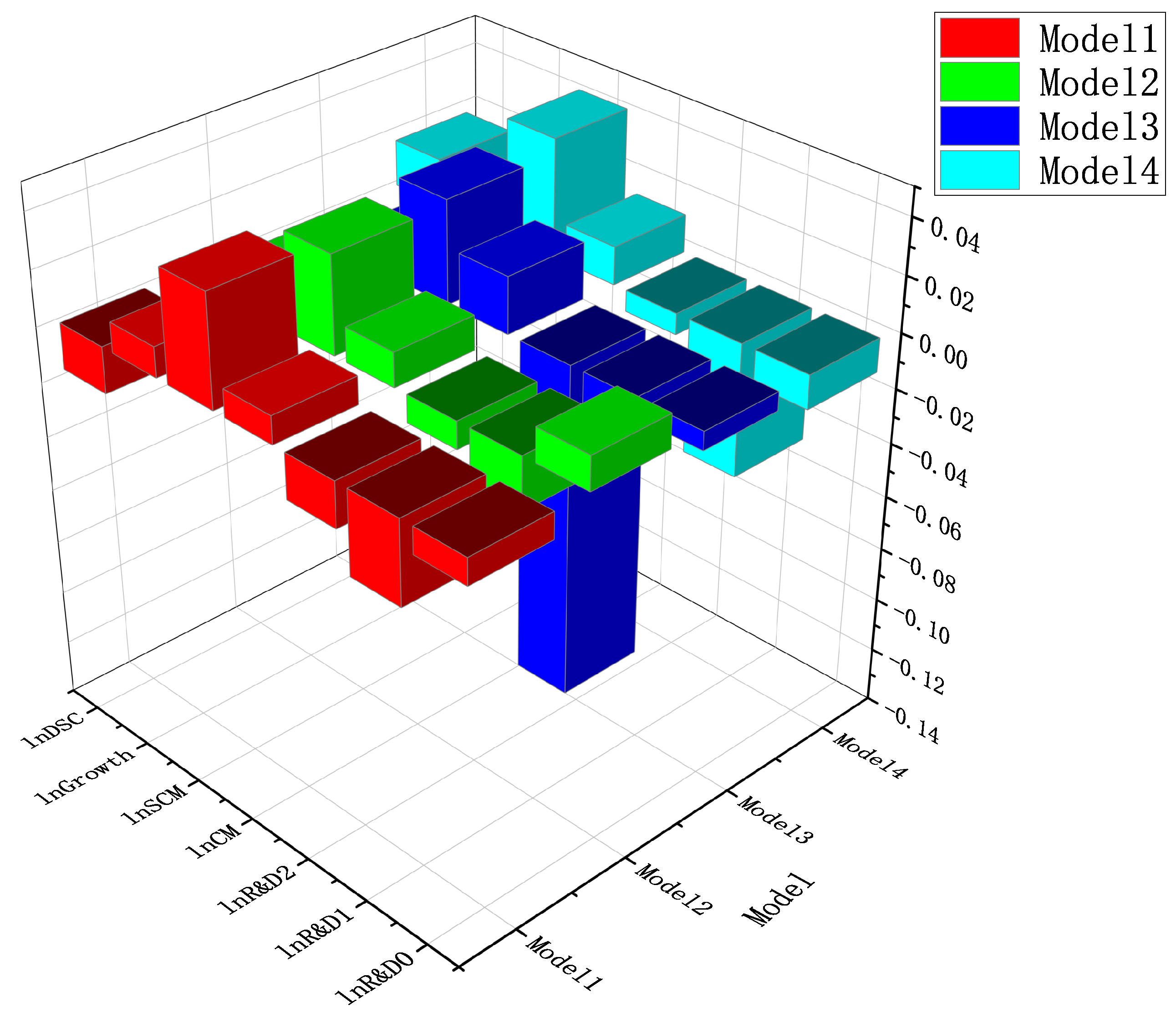


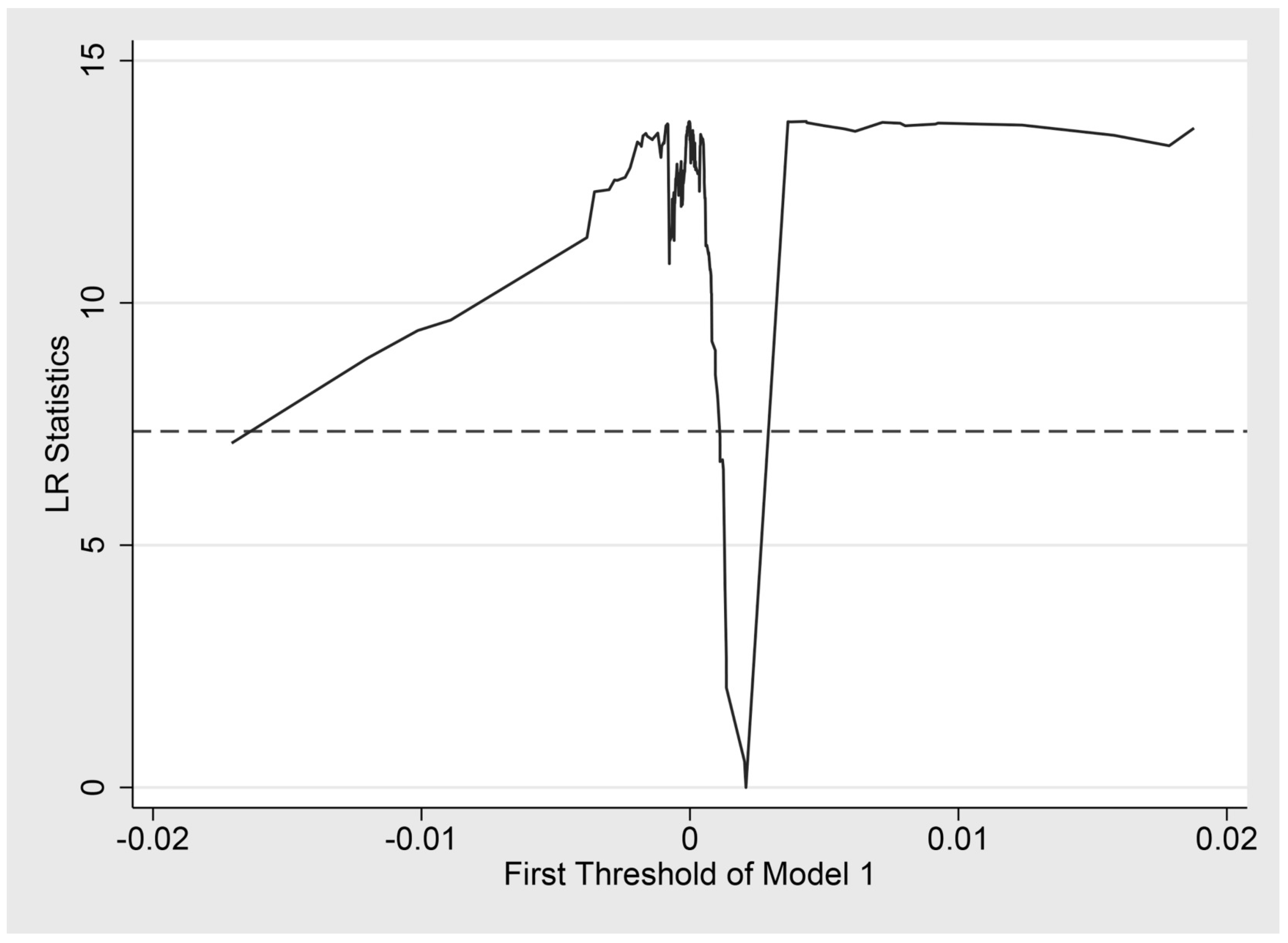
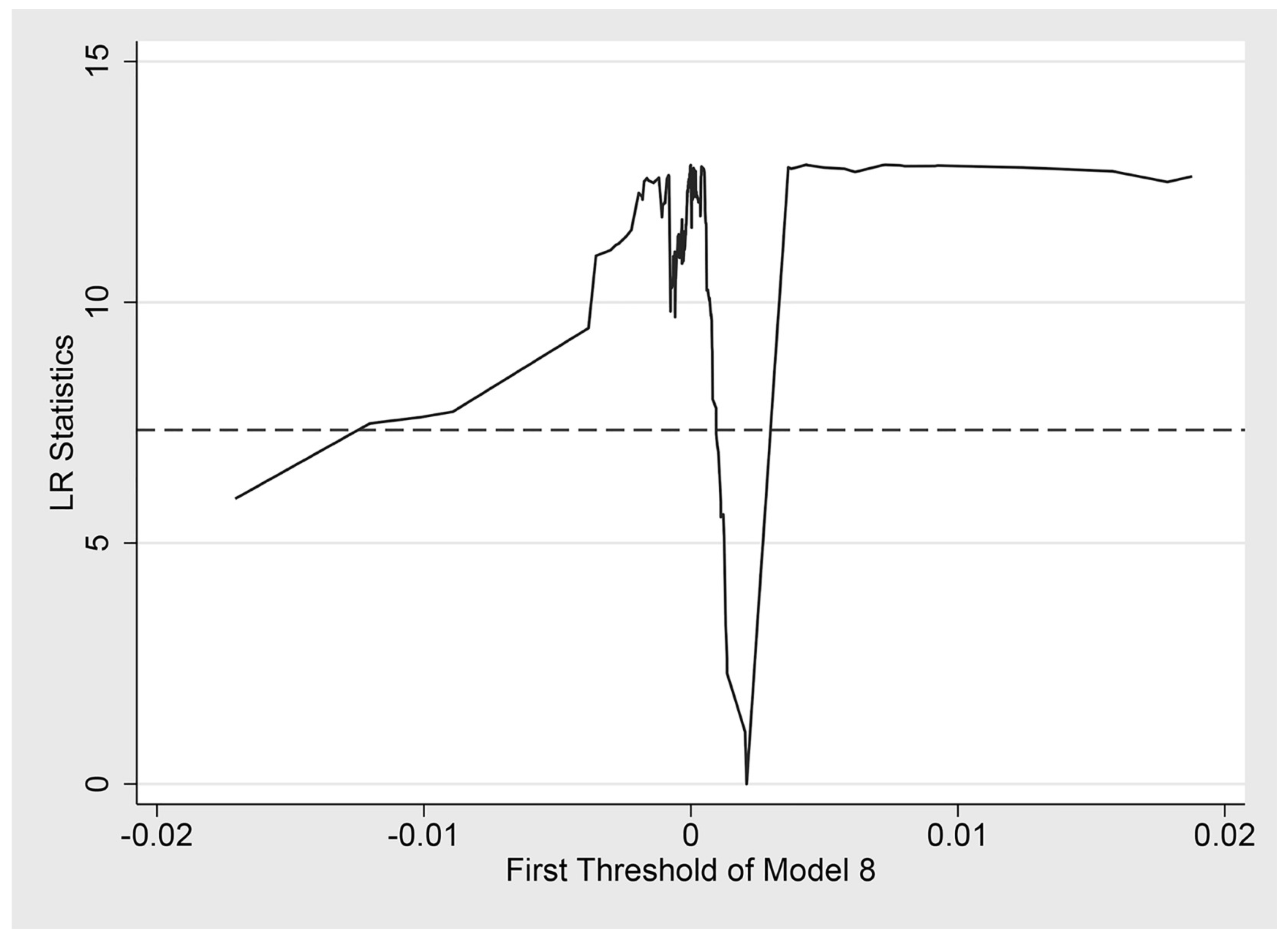
| Variables | Tier 1 Indicators | Secondary Indicators | Weights |
|---|---|---|---|
| Explanatory variables | Research and Development Innovation (R&D) | X1 = Number of R&D staff | 0.025348 |
| X2 = Number of R&D staff as a percentage (%) | 0.015784 | ||
| X3 = Amount of R&D investment | 0.033095 | ||
| X4 = R&D investment as a percentage of operating revenue (%) | 0.023971 | ||
| X5 = Amount of R&D inputs (expenses) expensed | 0.033869 | ||
| X6 = Amount of R&D investment (expenditure) capitalized | 0.076709 | ||
| X7 = Capitalized R&D investment (expenditure) as a percentage of R&D investment (%) | 0.051822 | ||
| Corporate Management (CM) | X8 = Equity concentration indicator1 (%) | 0.003983 | |
| X9 = Board size | 0.005340 | ||
| X10 = Whether the actual controller is the chairman or general manager | 0.018003 | ||
| X11 = number of shares held by the chairman | 0.046478 | ||
| X12 = Chairman’s shareholding (%) | 0.081623 | ||
| X13 = Total compensation of top three executives | 0.037186 | ||
| X14 = Total executive compensation | 0.074338 | ||
| X15 = Number of executives | 0.001475 | ||
| X16 = number of shares held by executives | 0.050831 | ||
| Supply Chain Management (SCM) | X17 = Net Inventory | 0.021952 | |
| X18 = Accounts payable turnover ratio | 0.095599 | ||
| X19 = Total asset turnover ratio | 0.033429 | ||
| X20 = Accounts receivable turnover ratio | 0.062244 | ||
| X21 = Inventory turnover ratio | 0.051612 | ||
| Control variables | Growth capacity (Growth) | X22 = Revenue on net assets growth rate | 0.012597 |
| X23 = Net profit growth rate | 0.000108 | ||
| X24 = Operating income growth rate | 0.121145 | ||
| X25 = Net asset per share growth rate | 0.000072 | ||
| Debt Service Capacity (DSC) | X26 = Cash ratio | 0.013378 | |
| X27 = Equity ratio | 0.003005 | ||
| X28 = Gearing ratio | 0.003859 | ||
| Explained variables | Corporate Performance (CP) | X29 = Revenue on net assets | 0.000133 |
| X30 = Revenue on investment | 0.000860 | ||
| X31 = operating profit margin | 0.000059 | ||
| X32 = Revenue on total assets | 0.000090 |
| Variables | CP | ||
|---|---|---|---|
| Model 1 | Model 2 | Model 3 | |
| 0.0000732 *** | |||
| (−0.0000243) | |||
| 0.00000693 *** | |||
| (-0.0000023) | |||
| lnCM | 0.0000548 ** | ||
| (−0.0000226) | |||
| lnCM2 | 0.00000637 ** | ||
| (−0.00000292) | |||
| lnSCM | −0.0000223 ** | ||
| (−0.00000946) | |||
| lnSCM2 | −0.00000279 *** | ||
| (−0.00000107) | |||
| D_DSC | −0.00252 * | −0.00254 ** | −0.00265 * |
| (−0.00147) | (−0.00128) | (−0.00147) | |
| D_SCM | 0.000420 *** | 0.000306 *** | |
| (−0.00015) | (−0.0000908) | ||
| D_CM | 0.000210 * | ||
| (−0.000123) | |||
| Constant | 0.000595 *** | 0.000528 *** | 0.000387 *** |
| (−0.0000592) | (−0.0000419) | (−0.0000162) | |
| 0.036 | 0.008 | 0.036 | |
| Observations | 440 | 440 | 440 |
| Explained Variable | Explanatory Variables | Threshold Variable | Threshold | F Value | p Value | Critical Value | Threshold Value | 95% Confidence Interval | ||
|---|---|---|---|---|---|---|---|---|---|---|
| 0.1000 | 0.0500 | 0.0100 | ||||||||
| lnCP | lnR&D | D_CM | Single | 12.32 * | 0.0990 | 12.0810 | 16.5120 | 26.6340 | 0.0030 | [−0.0268, 0.0079] |
| Double | 2.6900 | 0.7830 | 14.6870 | 21.0360 | 42.7240 | 0.0020 | [−0.0496, −0.0101] | |||
| lnR&D | lnSCM | Single | 25.62 *** | 0.0160 | 15.3250 | 19.5170 | 29.1820 | −7.8800 | [−0.0354, −0.0024] | |
| Double | 9.9800 | 0.2970 | 19.0980 | 27.7770 | 44.8460 | −6.6870 | [−0.0255, 0.0059] | |||
| lnR&D | D_Growth | Single | 3.4500 | 0.6000 | 14.8000 | 26.9290 | 52.8290 | 0.0000 | [−0.0230, 0.0097] | |
| Double | 45.12 *** | 0.0140 | 20.0380 | 27.1040 | 52.5980 | 0.0000 | [−0.0304, 0.0035] | |||
| Triple | 5.5800 | 0.4310 | 12.8750 | 18.9660 | 31.0550 | 0.0000 | [−0.1530, −0.0921] | |||
| lnR&D | D_DSC | Single | 15.28 ** | 0.0640 | 11.8340 | 17.6100 | 43.3630 | −0.0001 | [−0.0290, 0.0046] | |
| Double | 19.37 * | 0.0800 | 16.9630 | 23.9270 | 40.1180 | 0.0000 | [−0.0721, −0.0243] | |||
| Triple | 6.1200 | 0.5070 | 16.7320 | 24.4200 | 50.3080 | 0.0003 | [−0.0246, 0.0096] | |||
| lnCM | SCM | Single | 32.99 *** | 0.0150 | 17.0240 | 21.6770 | 44.7710 | 0.0010 | [ 0.0164,0.0811] | |
| Double | 8.3300 | 0.3990 | 23.3880 | 32.2870 | 56.5790 | 0.0000 | [−0.0223, 0.0323] | |||
| lnCM | D_Growth | Single | 4.1500 | 0.5140 | 13.2660 | 22.7310 | 39.0060 | 0.0000 | [−0.0056, 0.0548] | |
| Double | 32.91 ** | 0.0300 | 16.6240 | 23.7430 | 54.8750 | 0.0000 | [−0.0171, 0.0449] | |||
| Triple | 7.6600 | 0.2550 | 12.9570 | 16.6910 | 28.0610 | 0.0000 | [−0.1087, −0.0228] | |||
| CM | lnDSC | Single | 1.7100 | 0.8150 | 12.7900 | 21.6650 | 97.6070 | −6.2470 | [−0.5864, 1.6827] | |
| Double | 60.91 *** | 0.0080 | 18.6640 | 28.7170 | 53.7600 | −6.2530 | [−1.0439, 0.8456] | |||
| Triple | 2.2900 | 0.8310 | 21.5480 | 33.1740 | 64.7730 | −6.4950 | [7.3769, 13.3909] | |||
| lnSCM | D_CM | Single | 12.44 ** | 0.0570 | 10.1270 | 13.3990 | 21.1860 | 0.0030 | [0.0146, 0.0661] | |
| Double | 2.3700 | 0.8330 | 13.4580 | 21.5900 | 42.3600 | 0.0020 | [−0.0032, 0.0519] | |||
| lnSCM | lnDSC | Single | 16.99 ** | 0.0590 | 12.5520 | 18.3660 | 33.2160 | 0.0000 | [0.0105, 0.0615] | |
| Double | 8.0000 | 0.2890 | 14.7900 | 20.6070 | 35.6150 | 0.0003 | [0.0155, 0.0666] | |||
Disclaimer/Publisher’s Note: The statements, opinions and data contained in all publications are solely those of the individual author(s) and contributor(s) and not of MDPI and/or the editor(s). MDPI and/or the editor(s) disclaim responsibility for any injury to people or property resulting from any ideas, methods, instructions or products referred to in the content. |
© 2023 by the authors. Licensee MDPI, Basel, Switzerland. This article is an open access article distributed under the terms and conditions of the Creative Commons Attribution (CC BY) license (https://creativecommons.org/licenses/by/4.0/).
Share and Cite
Sun, Y.; Liu, H.; Liu, J.; Sun, M.; Li, Q. Analysis of Factors Influencing the Corporate Performance of Listed Companies in China’s Agriculture and Forestry Sector Based on a Panel Threshold Model. Sustainability 2023, 15, 923. https://doi.org/10.3390/su15020923
Sun Y, Liu H, Liu J, Sun M, Li Q. Analysis of Factors Influencing the Corporate Performance of Listed Companies in China’s Agriculture and Forestry Sector Based on a Panel Threshold Model. Sustainability. 2023; 15(2):923. https://doi.org/10.3390/su15020923
Chicago/Turabian StyleSun, Yong, Hui Liu, Jiwei Liu, Mingyu Sun, and Qun Li. 2023. "Analysis of Factors Influencing the Corporate Performance of Listed Companies in China’s Agriculture and Forestry Sector Based on a Panel Threshold Model" Sustainability 15, no. 2: 923. https://doi.org/10.3390/su15020923
APA StyleSun, Y., Liu, H., Liu, J., Sun, M., & Li, Q. (2023). Analysis of Factors Influencing the Corporate Performance of Listed Companies in China’s Agriculture and Forestry Sector Based on a Panel Threshold Model. Sustainability, 15(2), 923. https://doi.org/10.3390/su15020923







